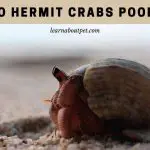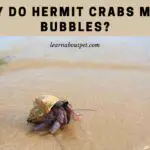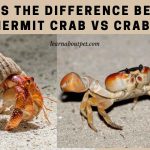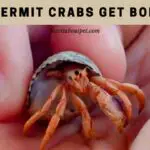Hermit crabs are a type of crustaceans which belong to the superfamily paguroidea. This crab species is adapted to “wear” empty scavenged mollusc shells with the aim of protecting their sensitive outer skeletons. It is also worth noting that there are an excess of 800 hermit crab species, a majority of which possess an uneven abdomen covered by a tightly fitting shell.
Talking of a hermit crab’s character traits, what about when it comes to a hermit crab burrowing?
Why do hermit crabs burrow? Burrowing is, in fact, a completely natural process that hermit crabs will show from time to time. There are several reasons as to why hermit crabs burrow themselves in the sand. It can range from a variety of reasons such as molting, stress reduction, moisture-search, and thermoregulation.
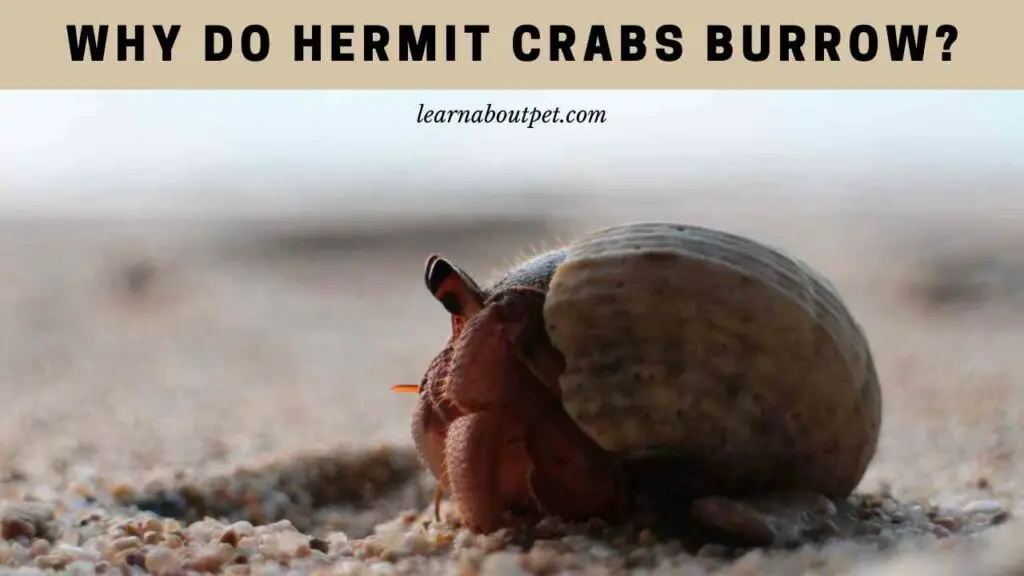
Hermit crabs, in simpler words, tend to burrow themselves in the sand whenever there is detection of external stress or internal physiologic stress to their bodies. Molting, especially, is a very stressful event in a hermit crab’s life.
During this period, the hermit crab leaves or sheds its exoskeleton and stimulates the formation of a new one. This process is purely physiological and internal to the crab and subjective in nature.
Why Do Hermit Crabs Burrow?
Hermit crabs will burrow for a variety of reasons, such as the search for moisture, molting, stress reduction, and thermoregulation, or regulation of temperature. It would therefore be safe to say that hermit crabs basically burrow, or bury themselves in sand, if they detect certain factors such as external or psychological stress. That said, burrowing is a normal and natural process.
Do Hermit Crabs Need Air Holes?
There’s no direct answer to if your hermit crab needs air holes in its shelter or container. Hermit crabs are classified into the animal kingdom as crustaceans who are specifically characterized by the presence of gills. Gills, to speak scientifically, are a respiratory organ that many aquatic and semi-aquatic animals have and they help in the absorption of oxygen from the water and excretion or release of carbon dioxide into the environment.
Coming to the point, do hermit crabs need air holes? Not necessarily. Because, as mentioned above, they ‘absorb oxygen’; just maintaining proper humidity in the surroundings will help and endure better health.
This can be done by monitoring the humidity levels in their tanks and other measures such as placing a damp towel in/over the lid of the tank.
According to the above information, why do hermit crabs burrow? Hermit crabs usually bury themselves in sand in search of moisture, to relieve stress, during molting, and for thermoregulation or body temperature regulation.
Why Do Hermit Crabs Bury Themselves?
Hermit crabs tend to bury themselves into sand or whatever base material they’re kept in (as a pet) either when there is external physical stress caused to them, or in events of some physiological processes such as molting, and thermoregulation.
Burying themselves is something natural that the hermit crabs do. In simpler words, whenever the hermit crabs detect stress within or outside them, they tend to seek protection by burying themselves.
So, according to what we’ve derived from the above information, why do hermit crabs burrow? Burrowing is a normal and natural process that hermit crabs and crabs in general undergo.
Hermit crabs will usually burrow when molting, alleviating stress, moisture search, and during thermoregulation.
Do Hermit Crabs Get Used To Their Owners?
It is a well known fact that not all pets are tamable. This is considering the fact that not all of them socialise well. Some may be real loners.
But in this case, when we are talking about hermit crabs – surprisingly, they don’t like to remain alone. In fact, they are really sociable creatures.
First up, they’d be really happy to share their habitat or shelter with other hermit crabs. Secondly, if you tame them well they will start to get used to you as their owners.
You have to be extremely calm and diligent while letting your hermit crab get used to you – from picking it up to letting it have its alone time when it is de-stressing. Once all this works, the hermit crab will get accustomed to their surroundings and to you.
Do Hermit Crabs Prefer To Live Alone?
As mentioned earlier, crabs don’t fancy being alone. In fact, hermit crabs enjoy a great sense of satisfaction being around similar creatures – other than hermit crabs. If not, they will gradually and slowly not only get accustomed to their surroundings, but also get used to their owner.
Once tamed, a hermit crab will listen and recognize its owner’s voice. You just have to be patient and believe in your hermit crab to build a good bond. This will require a lot of time as hermit crabs aren’t like the usual mammals.
Considering that hermit crabs are sociable animals, why do hermit crabs burrow, or bury themselves in sand? Hermit crabs burying themselves in sand doesn’t necessarily mean that they aren’t sociable.
He is probably just passing through a natural process. That said, hermit crabs usually burrow in search of moisture, when molting, thermoregulating, and stress reduction.
What Is Hermit Crab Molting?
Molting is a physiological and biological process that occurs in hermit crabs as well as other crustaceans, or rather molluscs. During this process, the skeleton (specifically, the exoskeleton) of the organism sheds off and a new external skeleton is formed.
This is a time-consuming process during which the organism, especially hermit crabs, get exposed and extremely vulnerable to potential predators.
It usually takes about four to eight weeks for your hermit crab to carry on a successful molting process after which the crab forms a new exoskeleton and survives with it.

The advantage and significance of molting is that the crab is allowed to grow larger in size, it can regenerate lost parts of the body and it will also get rid of any dead skin cells, dirt or parasites that might have been sticking to it.
Talking of molting, how is hermit crab molting related to Why do hermit crabs burrow? Molting is one one of the reasons hermit crabs burrow. Other reasons are the search for moisture, thermoregulation, and stress reduction.
Talking about what hermit crab molting is, what about when it comes to hermit crab molting pictures? The picture presented by a molting hermit crab is usually that of a relatively limp and lifeless hermit.
However, if you observe your hermit thoroughly, you will notice twitches that his body produces during the molting process.
Do Hermit Crabs Bury Themselves With Their Shell?
Mostly, hermit crabs do not bury themselves with their shells. They will commonly leave their shells and bury them within the base material.
When the hermit crab is molting, it will surely leave its shell and bury itself under the sand or base material.
You can even find the shell beside the spot where the hermit crab has decided to bury itself for the molting process. In other cases, such as de-stressing and thermoregulation, the hermit crab will not take long and will bury itself and come back up when it is done having its time. Sometimes your hermit crab could be just bored.
Talking of whether hermit crabs bury themselves with their shells, why do hermit crabs burrow to begin with? The primary reasons hermit crabs burrow is due to stress reduction, molting, thermoregulation, and moisture search.
When talking about whether hermit crabs bury themselves with their shells, what about when it comes to do hermit crabs burrow to sleep? Hermit crabs regularly crawl beneath their structure’s substrate to sleep. This offers them protection against light and heat.
They also do this to get the much needed humidity that they need for their survival. This is because humidity is vital to a hermit’s survival as they suffocate without it.
Hermit Crab Molting Stages
The molting process takes place in hermit crabs and enables them shed their old exoskeleton and produce a new one. It also helps them to grow larger in size and get rid of dirt, parasites that may be sticking onto them.
Molting in hermit crabs occurs in several stages.
Pre-molt Stage
In this stage the hermit crab starts to show the signs of the events that are going to occur, such as molting events. The old skeleton of the hermit crab will gradually slowly start detaching from your hermit crab’s body.
Molting stage
The water that hermit crabs absorb over the duration of the pre-molt stage is used to drastically increase the hydrostatic pressure of the hemolymph, which is the blood of the hermit crab.
This drastic and gradual increase in the hydrostatic pressure of the hemolymph helps in the detachment of the old exoskeleton.
Post-molting Stage
Now, in this stage, the newly formed exoskeleton will start to harden and the hermit crab will start to get adjusted to its surroundings and get back to a normal routine life. Here, the crab will require a lot of nutrition, especially minerals, and so it will ingest and eat its exoskeleton which is enriched with calcium. This will in turn help the hermit crab to harden the newly formed exoskeleton quickly.
Inter Molting stage
During this period, the crab grows in size and absorbs essential nutrients and minerals as well as water for the next molting event. Most importantly, the hermit crab takes a lot of rest during this period and tries to store as much energy as it can.
Molting is a vital part of a hermit crab’s life cycle. It’s also important to note that hermit crabs spend most of their lives either molting or preparing to molt.
Do Hermit Crabs Bury Themselves To Die?
Hermit crabs clearly don’t bury themselves to die. They can bury themselves for a variety of reasons though, ranging from molting (being the most important one) to de-stressing and regulating their body temperature.
Sometimes, they will just bury themselves to have some alone time.
So, in a nutshell, they don’t bury themselves to die. However, a failed attempt at molting may result in eventual death of the hermit crab.
How Long Do Hermit Crabs Bury Themselves?
How long crabs burrow will vary from one crab to another. However, the general rule is usually the larger the crab, the more extensive the whole process will take.
That said, it isn’t uncommon for a middle-sized crab to spend an average of four to eight weeks to finish the process. During this time your hermit crab may be completely buried in the sand.
How Can You Tell If A Hermit Crab Is Dying?
If you notice that your hermit crab isn’t moving for an excessively long period of time, he may be dead or dying. However, your hermit crab will decompose as soon as he dies. Soon after, the hermit crab’s carcass will begin to emit a strong odor.
Talking of how you know if a hermit crab is dying, what about when it comes to new hermit crab buried itself? Your hermit crab burying himself when he reaches his aquarium is usually a coping mechanism and it is therefore completely normal and natural. There is therefore no need for concern and you should avoid digging your hermit crab up and just let him be.
Talking of how to know when a hermit crab is dying, what about when it comes to hermit crab molting or dead? A molting crab will usually appear considerably limp and lifeless. Hermit crabs will also usually be halfway out of her shell while she is molting.
At times, you will notice some twitches that your hermit crab’s body produces when molting if you observe your hermit crab carefully. Otherwise, it can be quite difficult to tell whether your hermit crab is dead or alive.
Why Do Hermit Crabs Burrow Old Snail Shells?
Hermit crabs search for abandoned shells, sea snail shells to be precise. As soon as they get one that fits, they “wear” it and it becomes part of them. This characteristic of wearing a borrowed shell is the one that brought about the name ‘hermit crab”.
Final Verdict – Why Do Hermit Crabs Burrow
In conclusion, when it comes to the question why do hermit crabs burrow, we can say that crabs burrow, or bury themselves in sand so as to get moisture which is vital for their survival.

Hermit crabs can also burrow for other reasons such as molting, stress reduction, and regulation of body temperature, otherwise known as thermoregulation. That said, burrowing is usually a safe and natural process to your hermit and there is usually no cause for concern when your hermit crab does this. Enjoy hermit crab bubbles when it happens.
As a pet lover, make sure to learn about pet more and give your pet hermit crab a good and comfortable life!

Welcome to Learn About Pet. My name is Rajkumar Ravichandran and I love all pets, travel, and amazing food. I write about my passion and personal experience caring for multiple pets in this blog! ❤️
Post Disclaimer
DISCLAIMER: THIS BLOG OR WEBSITE, "Learn About Pet", DOES NOT PROVIDE YOU WITH MEDICAL ADVICE AND IS NOT A SUBSTITUTE FOR MEDICAL ADVICE. ALWAYS GET IN TOUCH WITH YOUR PERSONAL VETERINARIAN AND USE INFORMATION HERE AS GENERAL ADVICE.
The information, including but not limited to, text, graphics, images and other material contained on this website are for informational purposes only. No material on this site is intended to be a substitute for professional veterinary advice, food recommendation, diagnosis, or treatment. Always seek the advice of your veterinarian or other qualified health care provider with any questions you may have regarding a medical condition or for pet food related questions.


